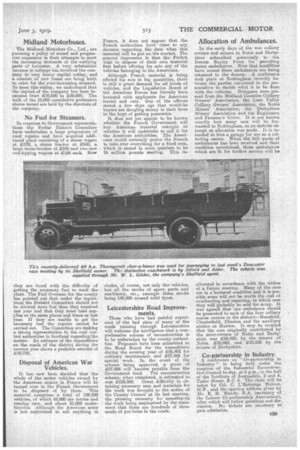Allocation of Ambulances.
Page 7

If you've noticed an error in this article please click here to report it so we can fix it.
In the early days of the war colliery owners and miners in Notts and Derbyshire subscribed generously to the Dennis Bayiey Fund for providing motor ambulances. Now that hostilities have ceased these ambulances are being returned to the donors. A conference took place at Nottingham recently between the parties concerned in the presentation to decide what is to be done with the vehicles. Delegates were present from the Midland Counties Colliery Owners' Association, the Leen Valley Colliery Owners' Association, the Notts Miners' Association, the Derbyshire Miners' Association and the Engincmen and Firemen's Union. It is not known exactly how many cars will be forwarded to Nottingham, ea no definite attempt at allocation was made. It is intended to hire a garage for use as a collecting centre. When the full quota of ambulances has been received and their condition ascertained, those ambulances which are fit for further service will be allocated in accordance with the wishes of a future meeting. Many of the cars are in a battered condition and it is poseible some will not be worth the cost of overhauling and repairing, in which case they will probably be sold for scrap. It was agreed that one ambulance should be presented to each of the four colliery rescue centres in the district—Mansfield, Chesterfield, Ilkeston and the auxiliary station at Manton. It may be recalled that the sum originally contributed by the mine-owners of Notts and Derbyshire was 250,893, by the miners of Notts. £32,000, and £22,530 by the millers of Derbyshire.






















